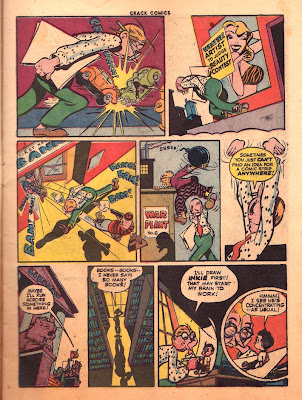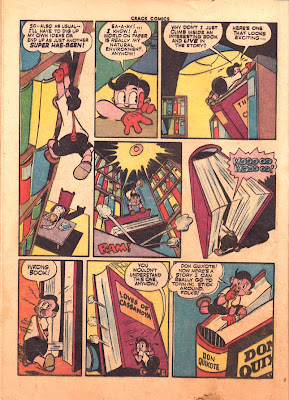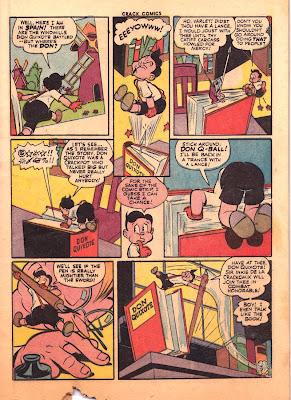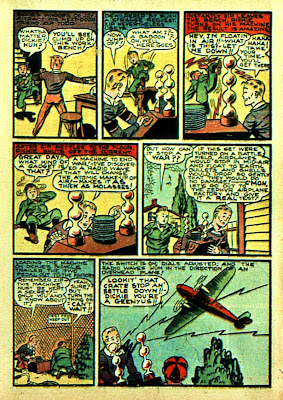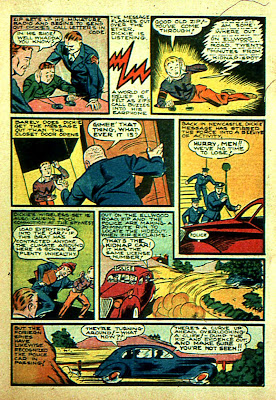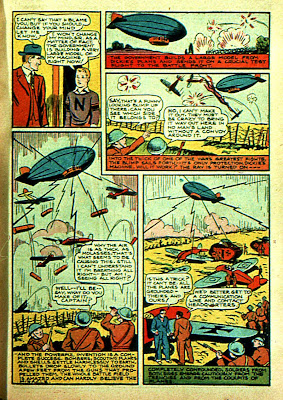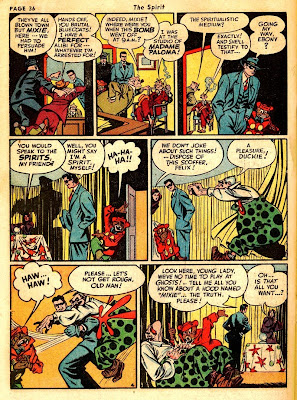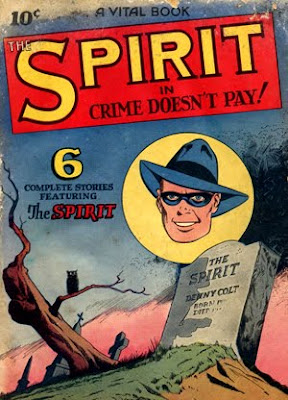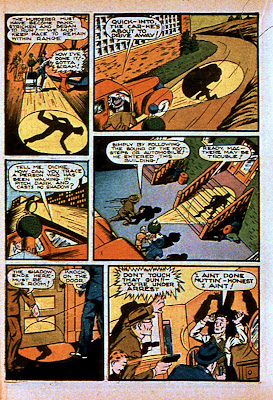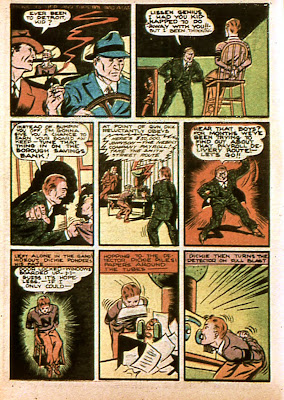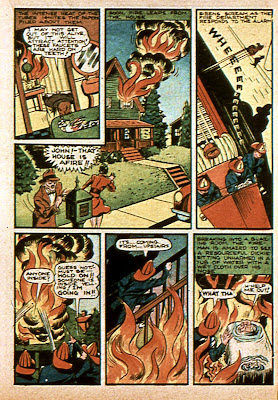Story presented this post:
Death Patrol - Mt. Fuijama (Story and art by Jack Cole)
Military Comics #31 (August, 1944 - Quality Comics) Jack Cole's eighth, and last, DEATH PATROL story from 1944 is a perfect storm of his unique design and stylistic elements - his "Cole-sisms."
Before we look at some of these, I have a little personal story to share.
I've been following a new blog,
The Panelogical Pantheon, in which the author -- a fellow comic book freak -- writes as much about his personal life as he does about comics. I cannot recommend this blog as his taste is different than mine, to put it politely, and he has some odd ideas (for instance, he insists on referring to Jack Cole as "John Cole"). This blog author, incredibly, seems to worship some of the worst comics ever done. However, his personal stories are interesting, and so, inspired by his example, I thought I'd share a little story with you about how I came to own a copy of the pages in this posting.
In 1982, I was 20 years old and living in Tallahassee, Florida with my girlfriend. One weekend, we had a tag sale in our apartment's front room. Among the people who came were a 19-year old guy, his girlfriend, and his younger brother (maybe 16). The boys saw part of my comic book collection in the living room and became very excited. I had a suitcase of old 1960's Marvels out.
The 19-year old fellow, who had a little fuzz on his upper lip and talked with a southern twang, insisted I sell him the suitcase. No way, I thought. He then told me he wanted to open up his own comic book shop and needed the collection for his stock. I asked if he had any golden age comics.
He said that he and his younger brother had broken into a deserted house and found in the attic a huge pile of golden age comics. Now THIS caught my attention! I told him I might consider a trade. He seemed to like the idea. I got his address and made plans to drop by his place that evening with my suitcase of silver age Marvel comics.
"At last!" I thought, my dreams of finding a horde of old golden age comics was becoming reality! I had feverishly desired to make just such a find for myself for nearly half of my 20-year old life!
When I arrived, they were having dinner. The boys lived with their mother. I was shown into a bedroom, where the golden age comics were. I was very excited. As we walked into the room, the boys explained that the comics they found were a little "torn up." They left me in the room and went back to finish their dinner.
There, in front of me were two large cartons, both filled with loose pages of golden age comics. The first thing I pulled out was the cover of
Plastic Man #1! I rooted around and saw the cover of
Four Color #9 (the very first
Carl Barks comic story and already worth some money back then), and a few pages from it, as well. There were pages from DC comics, Timely comics, and Quality comics from the early 1940s. In some cases, there was a complete coverless comic, or a near-complete section. It was both wonderful and tragic!
I wound up trading my suitcase of old Marvels for the two boxes of bits and pieces, and fifty dollars in cash. Soon after, the prices of the Marvels I had traded away began to rise, and had I held on to that box until today, they would be worth maybe 10 to 20 thousand dollars! No matter, I originally bought them all for ten cents apiece from The Book Nook in 1975.
At the time, finding golden age comics was totally out of the question. There were very few reprints around, and the original comics were out of my price range. At the time, I reasoned, this was my only chance to see this material!
My friend, and fellow comics freak
Frank Young (see his great blog,
Stanley Stories, devoted to the great comic book writer and artist John Stanley) and I spent many dizzying hours breathing in the acrid dusty fumes from these treasure boxes and sorting through them. Even then, Frank had an astonishing encyclopedic knowledge of comics and identified artists and writers I had never even heard of! We pieced together about three quarters of
Four Color #9 (which I later sold for a four hundred bucks on eBay), and several other cool items.
Among the pages, we assembled a small, fascinating pile of
Jack Cole comics, which I spent years studying. These pages sparked the interest in Cole's non-Plastic Man work that eventually led to the creation of this blog, 26 years later!
I recently excavated this stack of pages from the linen closet where I keep my pared-down comics collection (non-digital comics, that is!). My pal,
Frank Young, who has a top-notch scanner graciously scanned these pages for this blog. Thanks, Frank! There are a few items in this set that, as far as I can tell, have not previously been scanned or circulated, including this astonishing DEATH PATROL story from
Military Comics #31 (August, 1944):

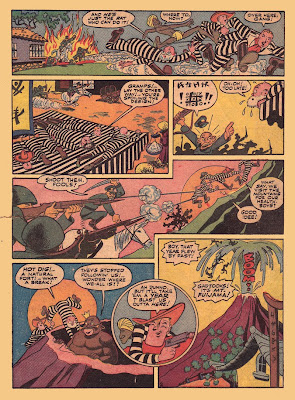


First off, it needs to be stated up front that the portrayal of non-white people in this story is disgraceful, and I do not approve. That being said, such portrayals were, sadly, the standard of the day. The portrayal of Japanese people in this way was probably a reaction to the very real threat Japan posed to the United States when they were at war.
From a design standpoint, this 4-page gem is a stand-out in Jack Cole's non-Plastic Man comic book stories. It ranks alongside the
fourth episode of Midnight (
Smash Comics #21), the
first Dickie Dean story (
Silver Streak Comics #3), the "Daredevil Vs. The Claw" story (
Silver Streak #7), and his one
QUICKSILVER story (
National Comics #13).
Unlike these other entries in the "Jack Cole Hall of Fame," this 4-pager falls short in the writing, but it is such an outstanding example of Jack Cole's visual style that it merits inclusion.
One of the things that makes Jack Cole's work great is that he invented numerous highly successful and unique stylistic and design elements. Over time, he accumulated a vocabulary of these elements which he used in his graphic storytelling to both distinguish his work and make vivid, entertaining stories. Several comic book artists accomplished the same feat with their own unique "isms."
For example, Jack Kirby's 1940's "isms" include extremely dynamic page layouts, foreshortening, and arms and legs that energetically break out of the panel borders, to name but a few. Steve Ditko's "isms" include slender, long-fingered hands in very specific tensed poses, and close-ups of fear-bulging eyes.
Let's take a look at page two of this story and study the stellar examples of six Cole-isms that are here. You can click on the page below to get a larger, more readable image:
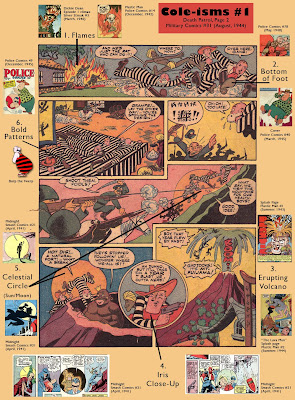 Cole-ism #1: Flames
Cole-ism #1: Flames From almost his first work in comics, Jack Cole loved to draw licking flames. Not only do they add drama to the story, but the way Cole drew flames was a study in the appeal of simple visual rhythm.
Cole-ism#2: Bottom of Foot
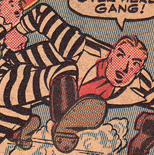
Perhaps Cole's first "ism," probably developed in his
Landon School of Cartooning exercises. You can see foot bottoms in his earliest "bigfoot" style work done in the Harry 'A" Chesler shop in the late 1930's. Cole kept this affectation up throughout his career. Drawing the bottoms of feet and shoes may have been a byproduct of a much harder to define Cole-ism having to do with how Cole positioned the human figure in "space."
Cole-ism #3: Erupting Volcano

Like FLAMES, this Cole-ism adds drama and must have been fun to draw. Cole liked this element so much he based one of his greatest PLASTIC MAN stories, "The Lava Man," from
Plastic Man #2 (Summer, 1944) around it. He used the erupting (or perhaps "ejaculating?") visual to great effect in everything from Plastic Man splash (no pun intended) pages, to humorous one-pagers (see the last Burp the Twerp page in
this posting).
Cole-ism #4: Iris Close-up

Used mainly in his early 1940's page layouts, this design element traces back to the style of pre-1929 American silent movies, which
Jim Steranko, Cole's best biographer to date, says Jack Cole loved to watch as a boy. In the way he would use the iris, or circular panel to break up a rhythm of squares, Cole simulated the "close-up" effect of early cinema. The circular panels add great visual interest to the page layout without detracting from the flow of the stories.
Cole-ism #5: Celistial Circles (Sun/Moon) 
Characters are framed and set off by all manner of enormous circular suns and moons in Cole's early to mid-1940's work. The celestial objects add drama and romance by their very presence, but they add visual interest by pleasantly contrasting with the forest of right angles that is the typical comic book page filled with square panels. Cole brilliantly used this simple design element to create depth of field in his panels. In his best work, including this DEATH PATROL story from
Military Comics #31, he creates a delightful visual resonance between the circles of the suns and moons and his IRIS CLOSE-UPs (Cole-ism #5).
Cole-ism #6: Bold Patterns

Jack Cole set his work apart and above that of many of his contemporary comic book artists by the masterful use of this one design element. He frequently made wild, bold patterns a part of his character's costumes, ensuring that there would automatically be plenty of eye-candy on the page. Consider WOOZY WINK's' polka-dotted blouse, of PLASTIC MAN's striped middle. Cole used patterns to create pleasing visual density. On special occasions, as in the example above, Cole's wild patterns also became a story element. (see also
this post).
There are many more Cole-isms to identify and look at. We'll return to this subject in a future post, as well as share more of the rarely seen material from my Tallahassee golden age score!
Reminder: your comments provide encouragement and helpful guidance. Please let me know what you think of this blog!

